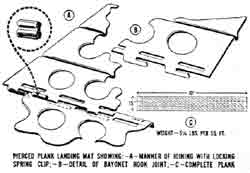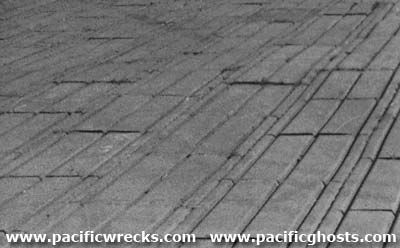 Allied: "Marston Mat" / PSP (Pierced Steel Planking)
Allied: "Marston Mat" / PSP (Pierced Steel Planking)
U.S. Army "Pierced Steel Plank" (PSP) or "Marston Matt" or "Marston Matting" was developed during World War II
and was widely used in every theater of operations. Each matt can be connected with tabs to the adjacent pieces using a sledgehammer to link the pieces together. Known as "Marston Mat" or "Marston Matting" for Marston, North Carolina near Camp Mackall Airfield where it was first used. Also misspelled as "Marsden Mat".
It was rigid enough to
bridge over small surface inequalities of the ground, it was mainly used to stabilized sub grade ground, and create taxiways, surface a runway or road. Some conception
of the logistics problems of war can be gained from the fact that some 60,000
pierced steel sheets 15 inches by 10 feet are required for a 150 by 5,000 feet
runway, weighing nearly 2,000 tons, requiring 35,000 cubic feet of cargo space
to be shipped overseas perhaps ten or twelve thousand miles. A runway this
size can could be put down in 175 hours by 100 unskilled laborers.
Nearly every American airfield in the Pacific used "marston matt". Even at larger
and more established bases with concrete runways, marston matting was often
used on taxiways or even for extra traction on roads.
Marston matting was also used in the Korean War. Even today, numerous examples of Marston Matt can be found all over
the pacific, often still in use to this day for the same purpose, or a variety
of other 'new' uses, including: fences, truck bed lining, pig-pens or foot bridges.
Japanese: "Landing Mat" (Tetsuban)
Research by Yoji Sakaida
 A
construction experiment was done at Mobara City, Chiba Prefecture during
1942 - 1943, testing landing matt. There
were several types: one was called "iron
plate paving" another "concrete paving", and a third "iron
net paving". During testing, many
iron plates couldn't be connected properly ,and deformation by bombing couldn't be
solved and the Japanese were short on materials.
A
construction experiment was done at Mobara City, Chiba Prefecture during
1942 - 1943, testing landing matt. There
were several types: one was called "iron
plate paving" another "concrete paving", and a third "iron
net paving". During testing, many
iron plates couldn't be connected properly ,and deformation by bombing couldn't be
solved and the Japanese were short on materials.
 Therefore, the Navy and Army did
not use it very much, and no improvements were made. But, the "Iron Net
Paving" did not have these problems. No record of its actual usage has
been found. Very few examples are know to this day. The lighter Japanese landing
matt appears to corrode much quicker, and any examples left today are flimsy
and rusted.
Therefore, the Navy and Army did
not use it very much, and no improvements were made. But, the "Iron Net
Paving" did not have these problems. No record of its actual usage has
been found. Very few examples are know to this day. The lighter Japanese landing
matt appears to corrode much quicker, and any examples left today are flimsy
and rusted.